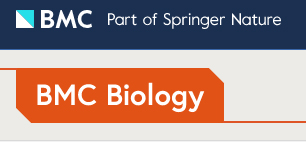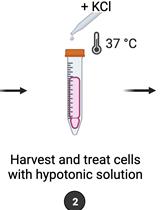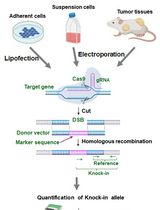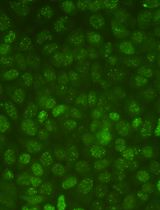- EN - English
- CN - 中文
Measurement of DNA Damage Using the Neutral Comet Assay in Cultured Cells
在培养细胞中使用中性彗星试验测量 DNA 损伤
发布: 2021年11月20日第11卷第22期 DOI: 10.21769/BioProtoc.4226 浏览次数: 4318
评审: Aksiniya AsenovaOmar AkilAnonymous reviewer(s)
Abstract
Maintenance of DNA integrity is of pivotal importance for cells to circumvent detrimental processes that can ultimately lead to the development of various diseases. In the face of a plethora of endogenous and exogenous DNA damaging agents, cells have evolved a variety of DNA repair mechanisms that are responsible for safeguarding genetic integrity. Given the relevance of DNA damage and its repair for disease pathogenesis, measuring them is of considerable interest, and the comet assay is a widely used method for this. Cells treated with DNA damaging agents are embedded into a thin layer of agarose on top of a microscope slide. Subsequent lysis removes all protein and lipid components to leave ‘nucleoids’ consisting of naked DNA remaining in the agarose. These nucleoids are then subjected to electrophoresis, whereby the negatively charged DNA migrates towards the anode depending on its degree of fragmentation, creating shapes resembling comets, which can be visualized and analysed by fluorescence microscopy. The comet assay can be adapted to assess a wide variety of genotoxins and repair kinetics, and both DNA single-strand and double-strand breaks. In this protocol, we describe in detail how to perform the neutral comet assay to assess double-strand breaks and their repair using cultured human cell lines. We describe the workflow for assessing the amount of DNA damage generated by ionizing radiation or present endogenously in the cells, and how to assess the repair kinetics after such an insult. The procedure described herein is easy to follow and cost-effective.
Keywords: DNA damage (NA损伤)Background
Maintaining DNA integrity is a pivotal prerequisite for cells to ensure that all physiological processes function immaculately. Cells are constantly exposed to a plethora of exogenous and endogenous agents that can damage their DNA. Examples of exogenous noxious agents include ultraviolet light, ionizing radiation, and reactive chemical compounds, while endogenous damage can arise for example due to reactive oxygen- and nitrogen species derived from cellular metabolism (van Loon et al., 2010). If left unrepaired, damage to DNA can lead to mutations, which can, in turn, alter the functionality of the affected DNA. This potentially results in altered protein abundance or activity, thereby giving rise to processes such as cancer, neurodegeneration, and ageing (Hoeijmakers, 2009; Markkanen, 2017). To counteract the deleterious effects of DNA damage, cells have evolved a series of intricate DNA repair mechanisms that detect and repair such insults (Ciccia and Elledge, 2010; Jackson and Bartek, 2009). Given the relevance of DNA damage for disease, it is of considerable interest to be able to measure levels of DNA damage that are induced by exposure of cells to particular agents, or to assess whether the repair kinetics of such damage is altered through specific treatments or genetic backgrounds. Methods to measure DNA damage and repair range from PCR-based methods and enzyme-linked immunosorbent assays, all the way to more elaborate next-generation sequencing based methods (Li and Sancar, 2020). Among this multitude of assays, the comet assay is a widely used method to measure both the amount of DNA damage as well as its repair in cells (Collins, 2014; Olive, 2009). For this, cells are treated with DNA damaging agents and embedded into a thin layer of agarose on top of a microscope slide. Subsequent lysis removes all protein and lipid components to leave the so-called ‘nucleoids,’ which consist of naked DNA remaining in the agarose. These nucleoids are then subjected to electrophoresis, whereby the negatively charged DNA migrates towards the anode. The migrating DNA, depending on its degree of fragmentation, creates shapes its degree of fragmentation and creates shapes resembling comets, which can subsequently be visualized and analysed by fluorescence microscopy. The comet assay can be adapted to assess a wide variety of genotoxins and repair kinetics, and both single-strand DNA breaks as well as double-strand breaks. In this protocol, we describe in detail how to perform the neutral comet assay to assess double-strand breaks and their repair in cultured human cell lines. This exact protocol was used in our recent publication (Clementi et al., 2020). For a detailed description of the alkaline comet assay that can be used to detect single-strand DNA breaks, please refer to the separate protocol that is published in Bio-protocol (Clementi et al., 2021).
Materials and Reagents
Superfrost microscopy slides (Superfrost Plus; ThermoScientic, Menzel-Gläser, catalog number: J1800AMNZ), store at room temperature
Square cover slips (Coverslips 22 × 50 mm; ThermoScientic, Menzel-Gläser, catalog number: MA062210), store at room temperature
24-well cell culture plates (TPP, catalog number: 92024), store at room temperature
15 ml Falcon tubes (Greiner ,188271 Zentrifugenröhrchen 15 ml, Producer: Huberlab AG, 7.188 271), store at room temperature
Normal melting point agarose (Standard Agarose-Type LE; BioConcept, catalog number: 7-01P02-R), store at room temperature
Low melting point agarose (Low Melt Agarose 100 g; Bio & Sell, catalog number: BS20.47.100), store at room temperature
Trypsin 10× stock solution (Gibco, catalog number: 15090-046), store stock solution at -20°C. Dilute 1:10 in 1× PBS for working solution, which is stable at 4°C for several weeks.
Potassium chloride (KCl) (Merck, catalog number: 1.04936.1000), store at room temperature
Na2HPO4·7H2O (Sigma-Aldrich, catalog number: S9390-1Kg), store at room temperature
KH2PO4 (Sigma, catalog number: 602187), store at room temperature
NaCl (Sigma, catalog number: 71380-1KG), store at room temperature
EDTA disodium salt dihydrate (C10H14N2Na2O8·2H2O) (Sigma-Aldrich, catalog number: 03685-1KG), store at room temperature
Tris base (Sigma, Life science, catalog number: T1503-500G), store at room temperature
Sodium hydroxide pellets (NaOH) (Merck, catalog number: 1.06498.100), store at room temperature
DMSO (Sigma-Aldrich, catalog number: D5879-1L), store at room temperature
Triton X-100 (MP-Biomedicals, catalog number: 807426), store at room temperature
SYBR Gold nucleic acid gel stain (Life Technologies, catalog number: S11494), aliquot and store at -20°C protected from light
N-Lauroylsarcosine (Sigma, catalog number: L5125), store at room temperature
Sodium acetate (C2H3NaO2) (Fluka, Biochemika, catalog number: 71183), store at room temperature
Lysis buffer (see Recipes)
Electrophoresis buffer (see Recipes)
Comet staining solution (see Recipes)
PBS (phosphate buffered saline) (see Recipes)
Equipment
Trevigen CometAssay ESII apparatus (Trevigen, catalog number: 4250-050-ES)
Fluorescent microscope capable of excitation between 470 and 530 nm to image SYBR-Gold (excitation maximum around 495 nm, emission approx. 537 nm)
Water bath able to keep a constant temperature of 37°C and large enough to hold a 250 ml glass bottle
Big styrofoam box or similar, large enough to hold a glass plate for 10-12 comet slides on ice
Small mechanic’s level
Coplin jars capable of holding 5 or 10 slides
Faxitron Cabinet X-ray system, Model RX-650 (faxitron.com)
Software
Fiji image processing package (https://imagej.net/Fiji)
OpenComet plugin for Fiji (http://www.cometbio.org/) (Gyori et al., 2014)
Procedure
文章信息
版权信息
© 2021 The Authors; exclusive licensee Bio-protocol LLC.
如何引用
Clementi, E., Garajova, Z. and Markkanen, E. (2021). Measurement of DNA Damage Using the Neutral Comet Assay in Cultured Cells. Bio-protocol 11(22): e4226. DOI: 10.21769/BioProtoc.4226.
分类
癌症生物学 > 基因组不稳定性及突变 > 细胞生物学试验 > DNA结构和改变
发育生物学 > 细胞生长和命运决定 > 成熟衰老
分子生物学 > DNA > DNA 损伤和修复
您对这篇实验方法有问题吗?
在此处发布您的问题,我们将邀请本文作者来回答。同时,我们会将您的问题发布到Bio-protocol Exchange,以便寻求社区成员的帮助。
Share
Bluesky
X
Copy link












